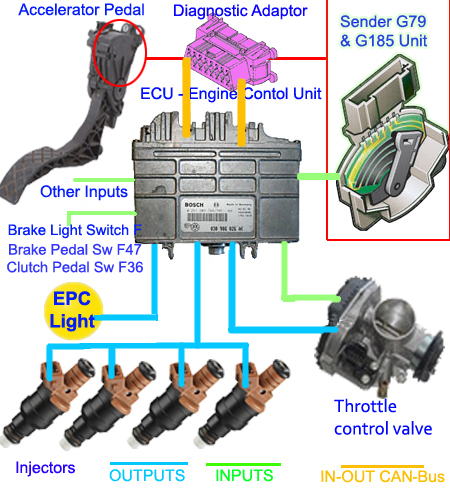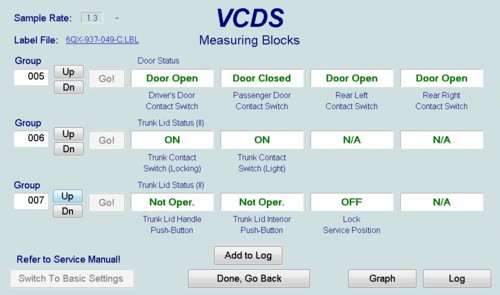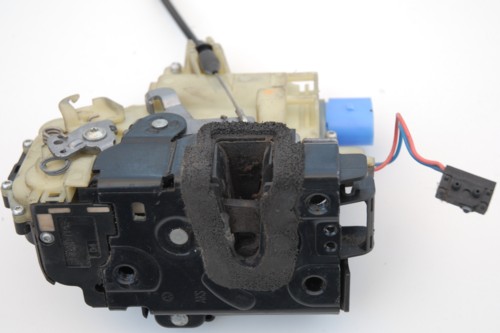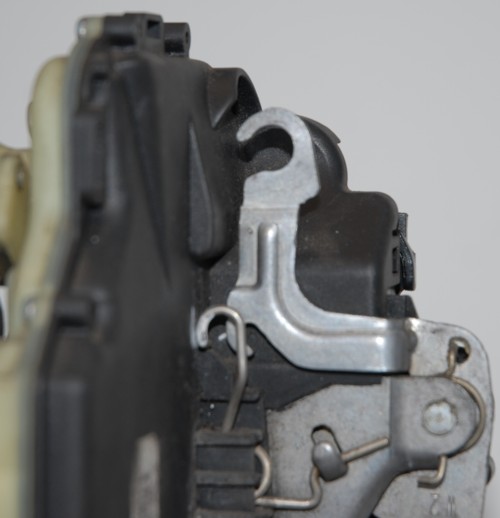EPC Q & A REVISTITED
Of late, Vag vehicle owners are experiencing Electronic Power Control problems more frequently than ever before yet most VW, Audi, Skoda and Seat still have no idea what an EPC fault is and what causes the EPC light to turn on. To add insult to injury some VW, Audi, Skoda and Seat service agents tend to "repair" these faults by trial and error, costing the vehicle owners exorbitant amounts of money only to later discover that the fault persists. The EPC warning light can be found in selected models in virtually all makes of cars and is not limited to just Volkswagen Audi, Skoda and Seat vehicles. Volkswagen Audi, Skoda and Seat use Electronic Power Control in their drive by wire vehicles as a safety feature which in my opinion isn't all that safe. Case in point, I have had my VW Polo go into limp mode whilst overtaking a car in a two way street. It stalled at the very moment when I was cutting-in in front of the said car, causing its driver to frantically brake and swerve to avoid colliding with the rear of my car because suddenly I wasn't accelerating any longer. Not to mention the on-coming car, which swerved toward the shoulder of the road since my car was straddling the white line. My EPC problem turned out to be the incorrect octane fuel.Be that as it may, by the time the EPC light illuminates in the dashboard, in response to some sensor detecting a problem, the problem already occurred in either the torque control, traction control, throttle body and sensors, accelerator pedal sensors, cruise control, fuel supply or ignition systems. Essentially the epc light is just a way to tell you that there is a problem with the drive by wire system and generally remain on until the fault is cleared. At the instant that the EPC light illuminates, the ECU flags a DTC which is then stored in the relevant electronic control module. This DTC gives a fair idea of the suspect system but cannot pinpoint the culprit component.
QUESTION?
Anonymous says:- Hey I have a 06 Passat 2.0t and I am reading all of these stories on the EPC my check engine light was already on while I was driving but the car was good. I was on my way to work after stopping at the gas station and my EPC light came on and my car stalled on the highway and has not came back on. The lights windows and everything works but when I try to turn the car on it attempts to turn but never does.ANSWER!
From your description I understand that after your EPC light came on, your car won't restart. So you checked the light and windows which tells me you suspected that the battery may have run down and perhaps not strong enough to turn the engine over. But you also mentioning 'check engine light'. A combination of check engine light and EPC light is emissions related and if your car's emissions exceed a predetermined level, the ECU will prevent the engine from starting. Its best that you have your car scanned to see what DTC it threw out.QUESTION?
Musa Brain says:- Hi there. I have a VW polo vivo I have the EPC light on when I'm driving slowly and also when I'm reaching a stop sign and hit the clutch pedal it turns off and when I start it in the morning it turns off so I have to rev it for it to idle but after some few minutes the EPC light comes on. Please help?ANSWER!
Musa your description of your EPC problem seems that you car doesn't idle fast enough. I assume that its drives normal whiles on a higher rev. It quite evident that it switches off when you come to a halt and whilst it's cold. I suspect that you have a blocked air filter problem that doesn't allow sufficient air to the MAF, but I could be wrong since you provide no DTC's. It could also be a blocked fuel filter that starves stichiometricity since torque is determined by both air and fuel.QUESTION?
Bogdan Iova says:- When I swich key on the EPC light not apear and teh engine not start. Golf 1.6 16VANSWER!
Bogdan, you really haven't given me much to work with here, but off hand it seems that you may have a blown fuse that powers the instrument cluster. Because the moment you turn on the ignition key, the OBD II system does a self diagnosis by turning on all the dash board lights for about 10 seconds whilst running the test. It then turns off those light related to the circuits that function normally and leaves those lights on, for circuits that fail the test. So, if you EPC light does come on when you turn on the ignition , then goes off, you don't have an EPC problem. However if your engine won't start it's obviously cause by something else. It could be that your battery has reached end of life. If the engine doesn't turn over, even the starter could have packed-up. But if it does crank and won't start, check your fuel gauge to at least determine that you have fuel in the tank. Related to this could be your ECM Power Relay, your fuel pump relay or the fuel pump itself. Without more info, this is about all I can help you with. DTC codes would have been helpful.QUESTION?
Anonymous says:- Hi there, I have a 2003 polo 1.6, EPC light is on and when it's idling can't rev it, checked and cleaned the throttle body and still same issue, ran a diagnostics check and it says something about the pedal, please help?ANSWER!
Hi Anonymous, you seem to have a classic EPC problem but for the benefit of everyone else, it would have been great to share the DTC codes that you recovered. I suspect it must have been one of the following codes since you mention the error code said something about the accelerator pedal.18038 P1630 Accel, Pedal Position -G79 signal too small (low)
18039 P1631 Accel, Pedal Position -G79 signal too largely (high)
18040 P1632 Accel, Pedal Position -G79 supply voltage malfunction
18041 P1633 Accel, Pedal Position -G185 signal too small
18042 P1634 Accel, Pedal Position -G185 signal too largely
18047 P1639 Accel, Pedal Position -G79 & -G185 out of range
You also mentioned that you checked and cleaned the throttle body. If you dismantled it in anyway, then you need to redo adaptation, else the ECU would have no idea how wide the butterfly valve has opened. Remember there is no throttle cable connecting the accelerator pedal to the throttle housing. This is known as a drive by wire system and it communicates the driver's torque demand to the ECU. The two potentiometers in the accelerator pedal assembly communicates the pedal position directly to the engine control module (ECM) using two separate signals, one signaling the pedal physical position and the other indicating rate of pedal movement. You will need a scan tool to do the adaptation because any faults in memory must be cleared before adaptation can be done.
The most common problem is the accelerator pedal itself. One or both of the potentiometers go high resistive/ intermittent and the accelerator pedal assembly should be replaced as a single unit. A tell tail sign of accelerator pedal trouble is that the engine revs higher than 800 rpm and at times the rev counter rises and falls continually whist idling, going as as high as 2000 rpm. If this happens, grab hold of the pedal whilst the car is idling and pull the pedal upwards, away from the floor. If the revs reduce and the surging stabilizers, replace the pedal. The image above shows idling whilst engine in surging and the image below shows idling with the pedal pulled up.



















